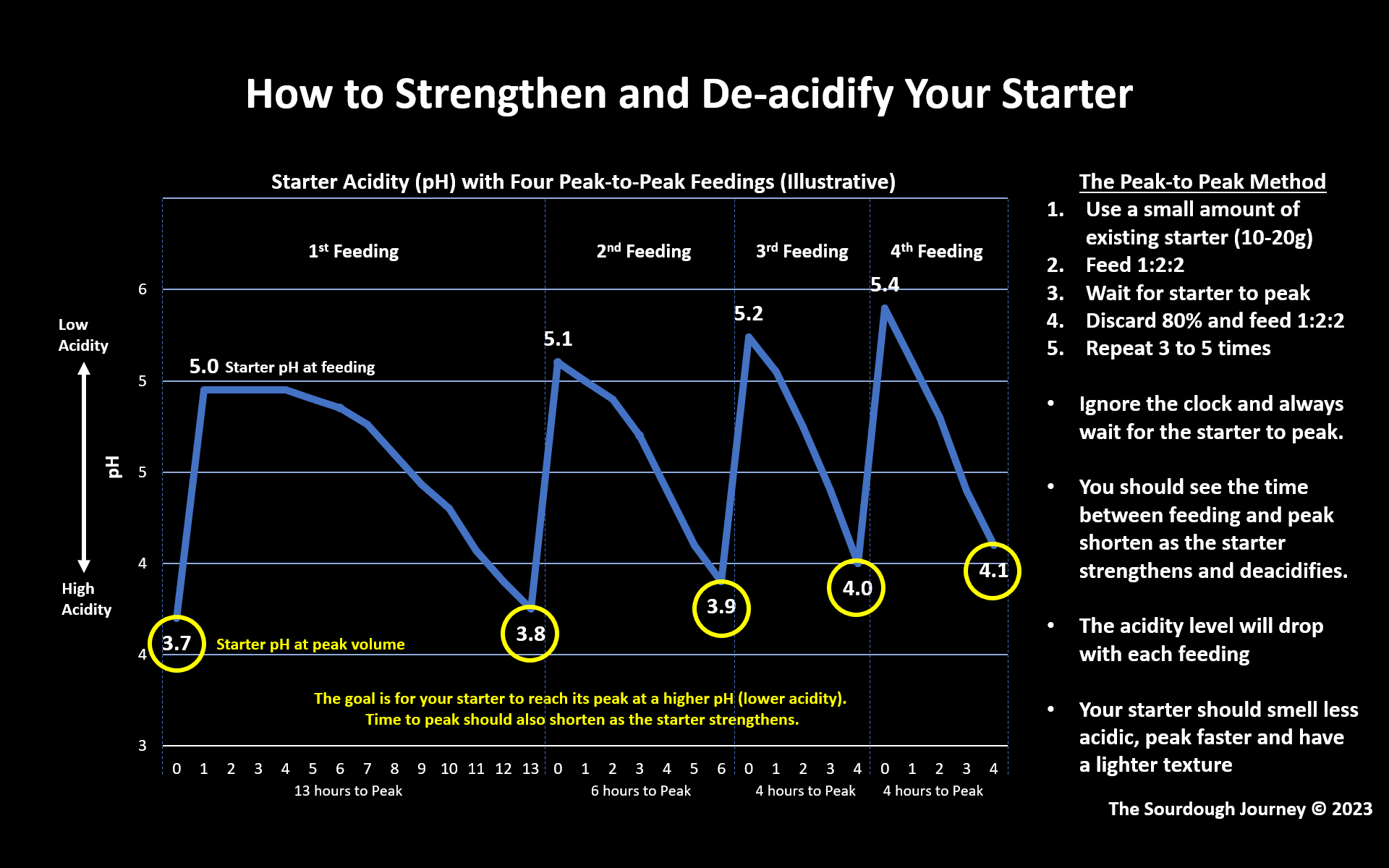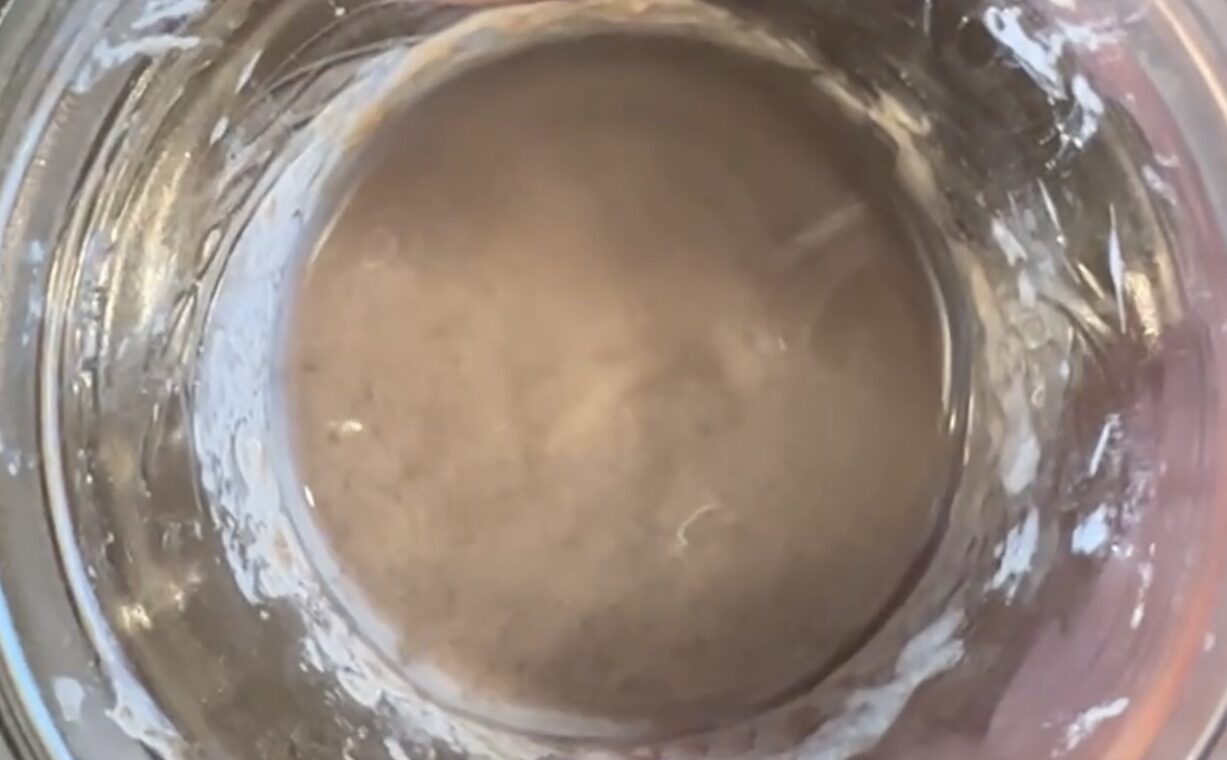My Sourdough Starter Smells Like Acetone (or alcohol, or vinegar, or beer, etc.) What should I do?
Understanding Different Aromas in Your Sourdough Starter
By Tom Cucuzza, The Sourdough Journey © January 2024
A sourdough starter can emit a wide range of aromas and odors. Learning how to interpret the smells can help you keep your starter happy and healthy.
The Starter Feeding Cycle and Common Aromas
When a sourdough starter is fed, it goes through the following six stages. The aromas emitted by your starter will change as it moves through the starter feeding cycle.

Common Aromas and Odors in a Sourdough Starter
1. Floury – Your starter will generally smell like flour and water when it is recently fed and as it begins rising.
2. Ripe/Sweet – Your starter will sometimes smell like ripe banana, apple, or cantaloupe. This is a natural byproduct of sugars fermenting in your starter. It is totally normal (and desirable) and often happens as a starter is approaching peak and for a short time after peak.
3. Beer / Wine – Some starters smell like beer or wine after they peak and begin falling. This is the early alcohol aroma and it is a natural byproduct of the yeast fermentation.
4. Acid / Vinegar – Some starters smell like cider vinegar as they progress through the feeding cycle and begin falling. An acidic odor is a natural byproduct of lactic acid bacteria and acetic acid bacteria. These are the beneficial bacteria in your starter that create the sour flavor in sourdough.
A “falling,” “fallen,” or “starving” starter will often smell acidic. But if your starter always smells acidic, even after feeding, that is generally not desirable. High acidity levels in your starter can choke off the yeast’s production of carbon dioxide.
Controlling your starter’s acidity is one of the most important skills to learn. Acidic starters cause lots of problems in sourdough loaves, such as gummy crumb, slow fermentation, flat loaves, weak oven-spring and premature overproofing.
If your starter is always strongly acidic smelling, you can de-acidify your starter by using a high feeding ratio (e.g., 1:5:5 or 1:10:10) or by doing a few rounds of “peak-to-peak” feeding – discarding and feeding as soon as the starter peaks.
Method 1: High Feeding Ratio – Discard most of your starter and use a very high feeding ratio (1:5:5 or 1:10:10). As soon as your starter peaks, resume your normal feeding method. Sometimes one large feeding will de-acidify your starter. If not, proceed to the “Peak-to-Peak Method.”
Method 2: “Peak-to-Peak” Feeding – Discard most of your starter and use a 1:2:2 feeding ratio. Watch your starter closely. As soon as it peaks, discard and feed again with a 1:2:2 ratio. Repeat this method 3-5 times over a few days – always discarding and feeding at peak. You should see you starter rise more quickly, smell less acidic and more “yeasty,” and the texturing should be lighter with more air and stringiness in the starter. After the Peak-to-Peak regimen, you can resume your normal feeding methods. You may need to use this method from time to time. It is like doing routine maintenance on a vehicle. Starters naturally become acidic over time.
5. Liquor/Booze – Some starters will smell like alcohol. This is ethyl alcohol which is a byproduct of yeast fermentation and usually occurs when the starter has fallen completely flat and is starving. It is most pronounced when all the bubbles have subsided, all flour has been consumed, and a thin layer of clear liquid forms on the top of the starter (a.k.a., “hooch.”) A strong ethyl alcohol smell means your starter is starving and needs to be fed. Hooch also very commonly occurs on the surface of refrigerated starters. It may also be gray in color as the alcohol oxidizes.
6. Acetone/Nail Polish Remover/Paint Thinner – Acetone is the trickiest aroma to diagnose. It can occur in any phase of the feeding cycle, and it can be caused by many different things. Generally it occurs when the yeast us “under stress.” This could mean your starter is:
· Too warm – Always keep your starter temperature under 80F/27C
· Too wet – Reduce the amount of water used to feed your starter
· Too acidic – See methods above for de-acidifying your starter
· Underfed – Do not let your starter fall completely flat between feedings. Use a higher feeding ratio if necessary.
· Microbial imbalance – Carry over less starter and use a higher feeding ratio. This favors the yeast over the bacteria. Also, do not seal your starter in an airtight jar. Cover it with a loose-fitting lid (not a paper towel, coffee filter or other porous material).
· Immature – Newer starters just need time to build a healthy microbial balance. I do not worry much about acetone odors in a new starter if you’ve ruled out the issues above.
Contrary to popular belief, the acetone odor does not always mean “your starter is hungry.” It can occur at any stage of the feeding cycle, and it is often persistent even when the starter is fed. In some cases, a type of bacteria may be present in your starter – it naturally produces acetone.
Acetone is a natural byproduct of fermentation. It’s root cause is often difficult to pinpoint and it can come and go over time. In general, if you keep your starter “healthy” the acetone odor will dissipate.
Newer starters (less than 30 days old) are generally more prone to acetone odors. They generally will dissipate as the starter matures.
In some starters the acetone odor is naturally persistent, and it is not something you can “fix” or “get rid of.”
Lastly, acetone has a very low boiling point, and it will turn to a gas and evaporate off in the oven when the loaf is baked. I’ve seen thousands of posts saying, “my starter smells like acetone,” and I’ve never seen a post saying, “my bread tastes or smells like acetone.” It will burn off in the baking process.
7. Other Odors and Aromas – Brand new starters created from scratch (i.e.,less than 10-14 days old) can emit all kinds of foul odors including old cheese, dirty socks, and vomit – to name a few. These odors naturally disappear as a starter matures and strengthens.
Learn more at thesourdoughjourney.com
More troubleshooting tips at thesourdoughjourney.com/encyclopedia
If you found this document to be helpful, please consider supporting The Sourdough Journey at thesourdoughjourney.com/donate/
Tom Cucuzza
Share:
Related Posts

Sourdough Starter: Refrigeration Maintenance Methods
How can I maintain my sourdough starter in the refrigerator instead of at room temperature?

The ULTIMATE Sourdough Bulk Fermentation Guide
When is sourdough bulk fermentation finished?

Dough Temping for PERFECT Sourdough Fermentation
What is sourdough “dough temping,” and how does it work?

The Science of the Peak-to-Peak Method of Strengthening a Sourdough Starter
What is the Peak-to-Peak Method and how does it strengthen a weak sourdough starter?

How to Strengthen a Weak, Acidic Starter
Is your sourdough starter sluggish? How do you identify and fix a weak, acidic starter. This document is the companion guide to the popular video “How to Strengthen a Weak, Acidic Starter.”
